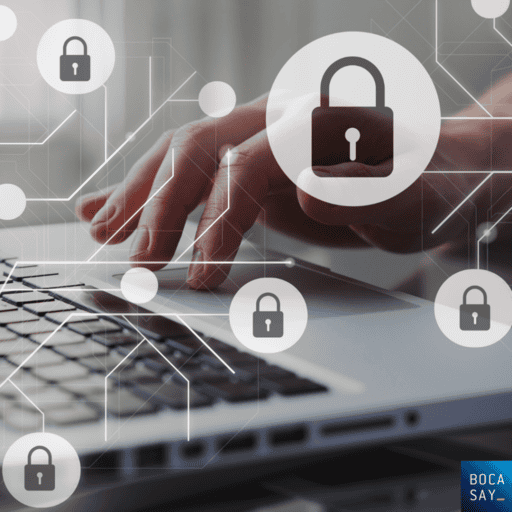What is cybersecurity and why is it essential?
This new article on cyber security aims to help you understand the concept of cyber security and all that it encompasses. We will also explain how to deal with a cyber attack.
What is Cyber Security?
Cyber security represents:
- data protection,
- the protection of computers,
- information protection,
- protection of devices,
- network protection.
The concept of cyber security encompasses everything that has to do with the protection of digital data that is stored or being exchanged. Cyber security is responsible for protecting this data against cyber threats and perpetrators.
Cyber security includes a set of defense methods presented below:
- Securing networks: the objective is to defend the computer network against intrusions.
- Protecting information (data): data can be in transit during an exchange from point A to point B. Even when data it is in motion, and especially when it is, it must be protected.
- Defend applications: this involves reducing the scope of any threat against devices, applications and software, which are the essential tools that enable the company to access data and conduct its business.
- Organize operations: users are the first source of vulnerability in the field of cybersecurity. They need to be made aware of the situation and equipped with the appropriate tools to ensure that they have the appropriate authorizations to access the network and the data that is stored and shared.
- Plan for business continuity and disaster recovery: after an incident, it is essential that business recovery takes place under the best possible conditions. The same applies to business continuity. In the event that the company has suffered an attack on its network, a business continuity plan has been developed in parallel to allow the company to continue its activities while the incident is taking place.
What is a cyber threat?
A cyber threat is an activity that aims to jeopardize the security of your digital environment. It can disrupt and alter the access, integrity or confidentiality of your digital systems and the data they contain.
A cyber threat environment corresponds to the spaces within which a malicious activity can be introduced. These environments include the following:
- Websites.
- The cloud (cloud storage).
- The intranet.
- VoIP: Voice over Internet Protocol.
- Accounts on social networks.
- Web applications.
- Mobile applications.
- Software.
- Smart devices connected to the Internet.
- Connected objects otherwise known as IoT (Internet of connected things).
- Platforms and e-commerce sites.
Definitions of a security breach vs. a security incident
It is important to know that every organization has rules and a policy in place to govern the organization’s security procedures. A security incident is an event that violates and endangers the security, integrity, availability or integrity of an organization’s information assets.
For a security breach to be qualified as a “vulnerability”, it must describe an event that is qualified as a data breach, as classified by established state laws such as ANSSI (National Agency of Security of. Information Systems) You can report your security breaches here.
Leave the implementation of cybe rsecurity in your company to the experts. On the Internet, no one is safe from malicious actions or unsolicited messages.Maltem Consulting Group provides experts in computer security to enable peace of mind for your digital assets and the data you store and handle.

How do you implement cyber security in your company?
Anticipating and implementing coordinated actions in several places will lead your company to build a solid IT security strategy. In the deployment of a cyber security strategy, many actors are involved and must be engaged:
- The IT department,
- All employees.
- Any person having access to the company’s network: service provider, supplier, electrician, etc.
All these people are involved in the protection of the organization’s data.
The efforts are therefore centered around 3 pillars:
- Technological effort: from a technological point of view, the company must be adequately and qualitatively equipped. Technical security actions must be implemented. These techniques will be deployed on all the entry or end points of the company. We are talking about devices, connected objects, routers etc. A system of rights management, identity and access management are the basis of any IT security strategy for a company.
- Process level effort: map all processes to be implemented in order to establish a solid and serious approach to dealing with potential cyber security events. All imaginary, potential and actual events should be listed and accounted for in each process. Processes should also be updated and monitored regularly to ensure security.
- People effort: we cannot say it enough, reinforcing the material and technical security is a good thing but training and sensitizing the individuals of the company is just as important, if not more. If your employees do not respect the rules laid down in your processes and regulations, you will never achieve the desired results. In addition, people are often the most common targets of malicious attacks. Train your staff and anyone else working with your company on good data security practices.
According to the cyber security framework of the National Institute of Science and Technology (NIST), which helps companies apply the right methods to manage cyber security risks, the key points to prevent and repair incidents are:
- Identify: detect the potential risks and vulnerabilities of the organization.
- Protect: implement actions to protect against possible attacks from inside or outside the organization.
- Detect: detect in real time attacks or potential intrusions against the organization.
- Respond appropriately to attacks.
- Recover and resume activities following an incident.